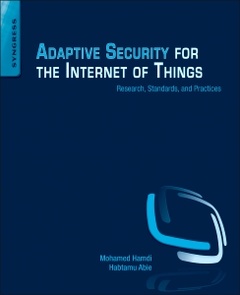Description
Adaptive Security for the Internet of Things
Research, Standards, and Practices
Author: Abie Habtamu
Language: English
Subjects for Adaptive Security for the Internet of Things:
448 p. · 19x23.4 cm · Paperback
Publication Abandoned
Description
/li>Contents
/li>Biography
/li>Comment
/li>
Adaptive Security for the Internet of Things: Research, Standards and Practices details the huge potential brought by the Internet of Things (IoT) paradigm and several significant obstacles that block the fulfillment of the IoT vision, including security.
The book assembles relating topics into a coherent body of knowledge consisting of theories, case studies, examples, and open problems, and builds on a set of formal and practical links to highlight the impact of the context on all the processes of the adaptive security engineering lifecycle, including an exploration of the idea that adaptive security should rely on an accurate representation of the dynamic context encompassing threats, energy level, and security requirements.
In addition, the book provides information on studying and analyzing the trade-off between security effectiveness and energy-efficiency. Researchers and practitioners will find a complete framework for the concepts and research being conducted around IoT security.
Chapter 1: IoT Security Challenges and Requirements
Chapter 2: Vulnerabilities and Threats for the IoT
Chapter 3: Standards and Practices for IoT Security
Chapter 4: Lightweight Cryptosystems for the IoT
Chapter 5: Adaptive Risk Management, Risk Analysis, and Risk Assessment for the IoT
Chapter 6: Identity Management, Authentication, and Anonymity in the IoT
Chapter 7: Resiliency and Security-Effectiveness in the IoT
Chapter 8: Security of Wearable and Implantable Body Area Networks
Chapter 9: Practical Implementation of Security Mechanisms for the IoT
Chapter 10: Distributed Monitoring for Adaptive Security in the IoT
Chapter 11: Context-Aware Threat Analysis for the IoT
Chapter 12: Formal Specification and Validation of Adaptive Security Policies for the IoT
Chapter 13: Game Theory and Applications to Adaptive Security for the IoT
Chapter 14: Learning Techniques for Real-Time Reaction to Security Attacks in the IoT
Chapter 15: Metrics for Adaptive Security in the IoT
Chapter 16: Verification and Testing of Adaptive Security Controls in the IoT
Chapter 17: Cross-Layer Design for Energy-Effective Security Mechanisms in the IoT
Chapter 18: Adaptive Authorization and Access Control Policies for the IoT
Chapter 19: Adaptive Security Engineering for the IoT
- Presents the most current and leading-edge research on adaptive security for the Internet of Things (IoT)
- Features a panel of top experts in the field who focus on the dynamic context of IoT security, including context-aware threat analysis, game theory and applications, learning techniques for real-time reaction to attacks, and distributed monitoring
- Covers best practices and standards for IoT security, including risk management and assessment, practical implementation of security mechanisms in IoT, and metrics for IoT adaptive security
- Includes coverage of key IoT security considerations, including energy efficiency, resiliency, effectiveness, and cross-layer design
These books may interest you

Securing the Internet of Things 51.74 €



